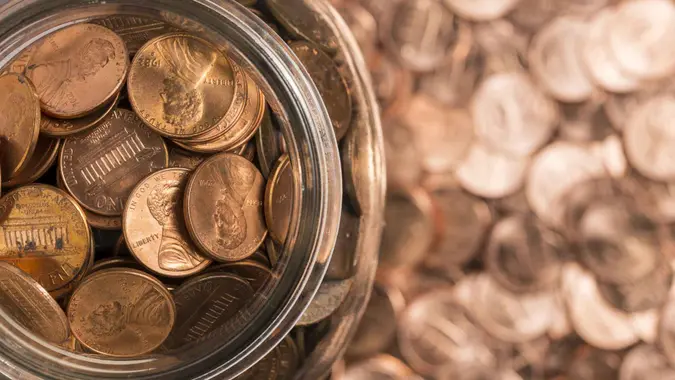4 Signs Stagflation Could Be Coming in 2025

Commitment to Our Readers
GOBankingRates' editorial team is committed to bringing you unbiased reviews and information. We use data-driven methodologies to evaluate financial products and services - our reviews and ratings are not influenced by advertisers. You can read more about our editorial guidelines and our products and services review methodology.

20 Years
Helping You Live Richer

Reviewed
by Experts

Trusted by
Millions of Readers
You’ve heard of inflation (and know how terrible it is), but have you heard of “stagflation”? It’s also terrible. Merriam-Webster defines stagflation as “persistent inflation combined with stagnant consumer demand and relatively high unemployment.” Yikes.
Some economic experts think that stagflation in the U.S. is on the horizon. Why? What signs indicate stagflation is coming and what can you do to financially prepare for it?
Slowing GDP Growth
A slowing GDP (gross domestic product) growth — when the economy’s output starts to decline or contract — is a big red flag warning of stagflation. And that flag was waved earlier this year. GDP decreased at an annual rate of 0.3% in the first quarter of 2025 (January, February and March), according to the advance estimate released by the U.S. Bureau of Economic Analysis [2].
“The Federal Reserve now projects real GDP growth at 1.4% for 2025, down from 1.7% in its March projection,” said Alex Tsepaev, CSO at B2PRIME Group. “The OECD and World Bank have also downgraded U.S. growth expectations due to trade tensions and policy uncertainty. Additionally, the Conference Board’s Leading Economic Index (LEI) declined again in May, marking a 2.7% drop over the past six months, which is approaching recessionary territory.”
Sticky Inflation
Back to the word so closely tied to “stagflation” — inflation. A key sign of stagflation is persistent inflation. This is also called “sticky inflation,” and we see it hover around essentials like food and fuel.
“These categories are less sensitive to interest rate hikes, which makes them persistently expensive,” said Dane May, principal and co-founder at DePaolo & May Strategic Wealth. “These are non-discretionary expenses that strain household budgets. When consumers are forced to spend more on essentials, they cut back elsewhere. That slows economic growth and makes inflation more painful because it’s tied to necessities rather than luxury or optional spending.”
Weakening Labor Market
Another key warning sign of stagflation is a weakening labor market. With this, we see a decrease in job openings, layoffs and rising unemployment rates. Right now, the labor market is showing signs of weakening.
“Recent jobs data has consistently missed economists’ expectations,” said Jake Falcon, CRPC, CEO at Falcon Wealth Advisors. “Employers added far fewer jobs in February than in January, and unemployment claims have risen. This softening labor market is a classic precursor to economic stagnation.”
Falling Consumer Sentiment
Next comes falling consumer sentiment, which, yes, we’re also seeing right now in the U.S. as people pull the reins on spending.
“Concerned by the inflationary outcome of the ongoing tariff war, people begin to feel pessimistic about the economy, which leads to reduced spending and investment,” Tsepaev said. “Indeed, retail sales fell 0.9% in May, worse than expected, as consumers reduced their purchases of big-ticket items, such as cars and other luxuries. Likewise, companies become cautious about expanding due to uncertainty or rising costs.”
Diversify Investments With Inflation-Resistant Assets
So how do you fortify your finances to shelter from stagflation? First, double down on your investing strategy. One of the awesome things about investing is that if you do it right and diversify, you can hedge against inflation.
“Consider Treasury Inflation-Protected Securities (TIPS), commodities and real assets like real estate,” Falcon said. “If you are missing these in your portfolio now is a time to get a second opinion.”
Pay Off High-Interest Debt
It’s always the right time to pay off high-interest debt, but there’s nothing like the high probability of stagflation to put the pressure on.
“When inflation increases, the true value of debt goes down,” said Fei Chen, investment expert and founder and CEO at Intellectia.AI. “But interest rates can also increase as central banks attempt to stem inflation, which increases the cost of borrowing. Paying off high-interest debt or fixing rates before inflation spirals out of control can provide some mitigation.”
Stay Informed and Be Flexible
The U.S. appears to be on the precipice of stagflation, but the economy can change rapidly and without notice. It’s important to keep up with the news (calmly and without letting it provoke you to, say, drop an investment without heavy consideration and research) and stay flexible.
“Regularly review your financial plan and adjust as needed,” Falcon said. “Make sure your portfolio is aligned with your financial plan.”
More From GOBankingRates
 Written by
Written by  Edited by
Edited by 

























